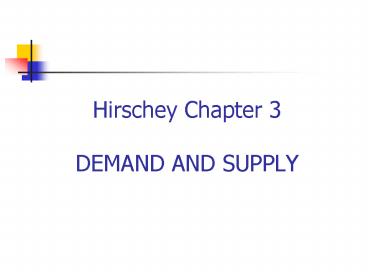Hirschey Chapter 3 DEMAND AND SUPPLY
1 / 19
Title:
Hirschey Chapter 3 DEMAND AND SUPPLY
Description:
Shows the relationship between quantity demanded and price, assuming that all other ... various prices within some given time period, other factors besides price held constant. ... –
Number of Views:330
Avg rating:3.0/5.0
Title: Hirschey Chapter 3 DEMAND AND SUPPLY
1
Hirschey Chapter 3DEMAND AND SUPPLY
2
Market Demand
- The quantity of a good or service that people are
ready to buy at various prices within some given
time period, other factors besides price held
constant. - Ready willing (preference) and able (income)
- The combined demands of all participants is
called the market demand.
3
The Law of Demand
- As the price of a good or service increases, the
quantity demanded decreases. - The demand curve is downward sloping.
Price
Quantity demanded
4
The Demand Curve
- Shows the relationship between quantity demanded
and price, assuming that all other factors are
held constant. - If price changes, the quantity demanded changes
and we have a movement along the demand curve. - If one of the nonprice factors change, the demand
changes and we have a shift of the demand curve.
5
Nonprice Factors
- Tastes and preferences
- Income
- Prices of related products
- Substitute products
- Complementary products
- Future expectations
- Number of buyers
6
Consumer Surplus
Area above the market price of the good but
below the demand curve.
Consumer Surplus
Consumer surplus is the value consumers get from
a good but do not have to pay for it. CS tells
how much extra money consumers would be willing
to pay for a given amount of a purchased product.
7
Market Supply
- The quantity of a good or service that people are
ready to sell at various prices within some given
time period, other factors besides price held
constant. - The combined supplies of all participants is
called the market supply.
8
The Law of Supply
- As the price of the product increases, the
quantity supplied increases. - The supply curve is upward sloping.
Price
Quantity Supplied
9
The Supply Curve
- Shows the relationship between quantity supplied
and price, assuming that all other factors are
held constant. - If price changes, the quantity supplied changes
and we have a movement along the supply curve. - If one of the nonprice factors change, the supply
changes and we have a shift of the supply curve.
10
Nonprice Factors
- Costs and technology
- Prices of other products offered by the seller
- Substitute products
- Complementary products
- Future expectations
- Number of sellers
- Weather conditions
11
Producer Surplus
Area above the supply curve but below the
market price of the good.
Producer surplus is the amount producers receive
in excess of the amount necessary to induce them
to produce the good.
12
Market Equilibrium
- The market will come to an equilibrium and clear
at the point where the quantity demanded is equal
to the quantity supplied.
Price
QS
Surplus
PE
Shortage
QD
Quantity
QE
13
Comparative Statics Analysis
- It is a sensitivity analysis in which managers
will ask What if questions regarding demand and
supply. - Analysis starts with one equilibrium point and
jumps to the next equilibrium (statics), while
comparing the differences in market conditions
between the two situations.
14
Comparative Static Analysis
- Short run change Increase in demand causes price
to increase. - Long run change Supply increases as new sellers
enter the market and original sellers increase
production capacity.
QS,1
2
QS,1
P2
3
P3
P1
1
QD,2
QD,1
Q1
Q3
Q2
15
Comparative Static Analysis
- Short run change Decrease in demand causes price
to fall. - Long run change Supply decreases as less
profitable firms or those experiencing losses
exit the market or decrease production capacity.
16
Comparative Static Analysis
- Short run change Increase in supply causes price
to fall. - Long run change Demand increases as tastes and
preferences of consumers eventually change in
favor of the product relative to substitutes.
17
Comparative Static Analysis
- Short run change Decrease in supply causes price
to rise. - Long run change Demand decreases as tastes and
preferences of consumers eventually change away
from the product and toward the substitutes.
18
Price Restrictions
- Price Ceilings
- The maximum legal price that can be charged in a
market
Lost producer and consumer surplus
Price
QS
PF
PE
Ceiling
PC
Shortage
QD
Quantity
QE
QD
QS
19
Price Restrictions
- Price Floors
- The minimum legal price that can be charged in a
market
Price
QS
Surplus
PF
Floor
PE
Cost of purchasing excess supply
QD
Quantity
QE
QD
QS































